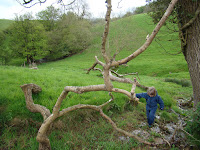 |
| Looking N towards Cold Ashton; 27th April 2012 |
Cold Ashton is a hamlet of church and manor house, south facing and sheltered (the 'Cold' an elusive prefix); and sharing its locale with many small valley's busily incising the long finger of the Cotswold scarp slope and narrow plateau that extends down to Bath, 3 miles to the south.
Less than half a mile but hidden away from the prosaic noise of the A48, leaching the masses from the London-West whale-road into Bath, its the best sort of place: an easily accessible backwater that most people have no idea is there. From the single quiet lane, a footpath descends steeply as you enter the bowl-like head of a small valley; a 'combe' in this part of the world, vernacular descriptor hitting the spot nicely: 'The Combe was ever dark, ancient and dark' (Edward Thomas, 'The Combe'). Halfway down the slope spring's bubble from the limestone and spill out gentle, cress-bound streamlets that flash in the sunshine and chatter their course downward. This is Cotswolds scenery at its simplest and purest, before the gentle but incipient gentrification by Range Rover, impeccably imagined cottage restoration and horse pasture further down the valley.
 |
| Your playground awaits |
 |
| Leave me alone Dad! |
Contrary to the National Trust's predictably paternalistic but misguided advice in its '50 things to do before you are 12', '...so long as you always have an adult with you', this quietly mysterious valley is exactly the sort of place where children need no more than an adult steer in the right direction; an opportunity for a glorious compromise where parents have a leisurely picnic, beer and sleep in the sun whilst the kids range through the woods, streams and fields. Enlightened self-interest is a wonderful thing.
 |
| Monster of wood |
Previous 'Landscape in particular' posts:
Kenilworth Castle
Bolton Abbey





